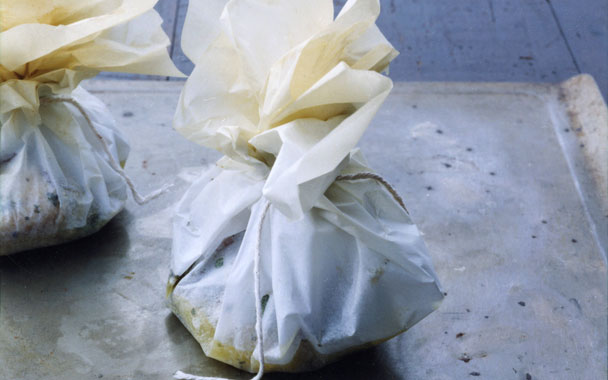All the cool kids these days are cooking meals sous vide, sealing food up in plastic bags and cooking it just so at very precise temperatures to carefully control the flavor and texture. Like any food dork, I, too, covet a chamber vacuum sealer and an immersion circulator but, in the absence of an extra couple thousand dollars, I resort to sous vide’s older, cheaper, but still delicious cousin: cooking dinner en papillote.
Cooking something en papillote means wrapping the food in a pouch and baking it in the oven. It’s a wet method, technically, since the food doesn’t roast but steams in its own juices. The French cut a piece of parchment (papillote) in the shape of a heart with a crease down the middle, but aluminum foil is a good alternative, since it holds creases better and makes the whole processes seem less fussy and more Boy Scout–like.
There are a bunch of reasons to try cooking this way. 1) It’s super-flexible—you can cook anything en papillote, though fish and vegetables are my favorites. 2) You can make the pouches hours ahead and hold them in the fridge, and 3) you can cook as many pouches at once as will fit in your oven. Big dinner parties don’t get any easier. Plus, 4) it’s incredibly tasty, since the moisture in the food gets converted to saucy goodness waiting to be poured from the pouch into a bowl.
The technicalities are simple. Lay out a big sheet of parchment or foil. Butter or oil the inside if you’re worried about things sticking. Make a pile of grains and/or vegetables, par-cooked if they won’t be done in as long as it takes the other ingredients, and remembering that greens like spinach will wilt to nothing when they’re cooked. Top that with fish or even meat if you like. Fold the pouch so it’s sealed up airtight and put it on a baking sheet in a hot oven (400-450° F) for 20 to 30 minutes. (Overcooking is a little less of a disaster when steaming than with other techniques.) If you’ve used parchment the bag will be puffed up like a balloon, and you can let everyone open his own pouch.
Cooking en papillote plays up clarity and delicacy—think mild fish (trout, halibut, snapper), vegetables, and especially herbs, which greet you with a faceful of aroma when you open each pouch. I cooked haddock with zucchini, young summer carrots, Haruki turnips, and a ton of lemon verbena this week, and it was the best use I’ve ever found to show off that vibrant but fragile herb.
But delicate doesn’t mean wimpy. Michael Anthony from Gramercy Tavern suggested “putting some hearty greens in the base, like chard or mizuna or lambs’ quarters. They give off delicious mineral qualities. And serve the packets with a compound butter of lemon, sea salt, and Aleppo pepper.” Sign me up.




 Pinterest
Pinterest


